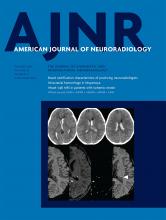Abstract
BACKGROUND AND PURPOSE: The internal cerebral vein begins at the foramen of Monro by the union of the thalamostriate and the anterior septal veins. The lateral direct vein is its other major tributary. Numerous researchers have reported differences in internal cerebral vein branching patterns but did not classify them. Hence, the objectives of this study were to evaluate the anatomy of the internal cerebral vein and its primary tributaries and classify them depending on their course patterns using CTA.
MATERIALS AND METHODS: Head CTAs of 250 patients were evaluated in this study, in which we identified the number and termination of the anterior septal vein and the lateral direct vein. The course of the lateral direct vein and its influence on the number of thalamostriate veins and their diameters and courses were assessed. The anterior septal vein–internal cerebral vein junctions and their locations in relation to the foramen of Monro also were evaluated.
RESULTS: We classified internal cerebral vein branching patterns into 4 types depending on the presence of an extra vessel draining the striatum. Most commonly, the internal cerebral vein continued further as 1 thalamostriate vein (77%). The lateral direct veins were identified in 22% of the hemispheres, and usually they terminated at the middle third of the internal cerebral vein (65.45%). The most common location of the anterior septal vein–internal cerebral vein junction was anterior (57.20%), with the anterior septal vein terminating at the venous angle.
CONCLUSIONS: Detailed knowledge of the anatomy of the deep cerebral veins is of great importance in neuroradiology and neurosurgery because iatrogenic injury to the veins may result in basal nuclei infarcts. A classification of internal cerebral vein branching patterns may aid clinicians in planning approaches to the third and lateral ventricles.
ABBREVIATIONS:
- ASV
- anterior septal vein
- ICV
- internal cerebral vein
- LDV
- lateral direct vein
- TSV
- thalamostriate vein
- © 2019 by American Journal of Neuroradiology












